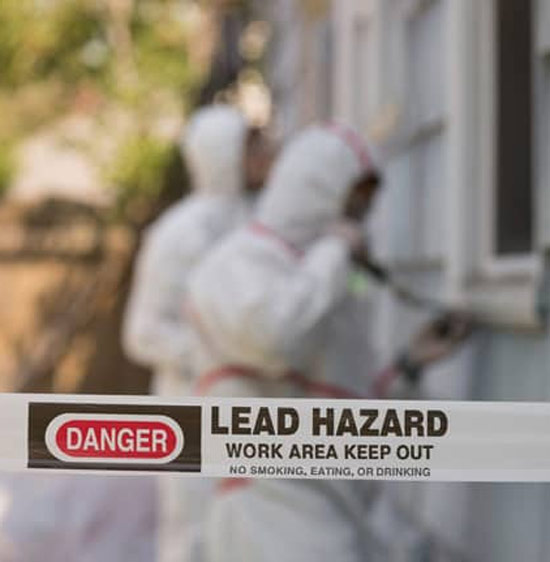Vital Tools and Strategies for Reliable Lead Violation Cleanup
Attending to lead violations effectively necessitates a thorough method that blends the right devices with critical techniques. The very first step involves gearing up employees with Personal Protective Equipment (PPE) to secure their wellness. Concurrently, using specialized clean-up devices, such as HEPA vacuum cleaners and lead-specific cleaning representatives, is important for detailed impurity removal. Effective control techniques, consisting of plastic sheet and unfavorable air pressure systems, are essential to protect against the spread of unsafe products. Risk-free disposal techniques and strict adherence to regulatory standards make sure accountable handling of toxic waste. What are the nuanced methods that really make a difference?
Personal Protective Tools
Personal safety equipment (PPE) is a crucial component in the reliable monitoring of lead contamination cleaning. PPE functions as an important barrier, guarding workers from the hazardous impacts of lead exposure, which can lead to extreme health and wellness repercussions. The vital PPE for lead cleanup consists of respirators, protective clothing, handwear covers, and eye defense. Each kind of devices is specifically developed to reduce different risks related to lead bits and dirt.
Respirators, especially those geared up with HEPA filters, are essential for filtering system air-borne lead particles, avoiding breathing. Proper fit and seal checks are vital to guarantee their performance. Protective apparel, including coveralls and disposable suits, prevents lead dirt from adhering to workers' garments, lowering the threat of second contamination. Handwear covers, usually made from nitrile or latex, secure the skin from direct call with lead, while safety goggles or full-face shields protect the eyes from dust and particles.
Furthermore, rigorous training on the right usage and upkeep of PPE is important. Employees must be enlightened on donning and doffing treatments to avoid contamination. Routine examinations and replacements of PPE parts are required to preserve their safety capabilities, making sure a safe and compliant cleaning operation.
Specialized Clean-up Devices

One more essential tool is the wet/dry vacuum cleaner, which can effectively clean up both dirt and fluid contaminants. These vacuums typically feature HEPA filters to give an additional layer of safety and security. Wet wipes or tack cloths are likewise critical for surface area cleansing; they are specifically created to capture and hold lead particles, reducing the danger of spreading out contamination.
For even more stubborn deposits, specialized lead-removal cleaner are called for. These agents are developed to damage down lead bits, making them easier to remove. Scrub brushes with sturdy bristles can help in this procedure, specifically on harsh surfaces where lead dust has a tendency to adhere more highly.
Additionally, encapsulants are utilized to secure lead-contaminated surfaces, preventing the release of lead dirt. These specialized paints and coverings are made to follow various substrates, supplying a lasting service for lead control.
Reliable Control Techniques
Reliable control approaches are vital in mitigating the spread of lead contamination during clean-up activities. Carrying out durable control methods guarantees that lead bits do not migrate to untouched locations, consequently safeguarding both workers and the environment. One key technique is the use of plastic sheeting to seal infected zones. Heavy-duty polyethylene obstacles can be set up from floor to ceiling to develop a regulated job area, considerably reducing the threat of airborne lead dust dispersal.

To boost containment, encapsulants can be related to surfaces that are not being gotten rid of or disturbed. These specialized layers bind lead dirt, minimizing its availability for resuspension. In addition, all workers have to use appropriate Individual Protective Devices (PPE), consisting of respirators and non reusable matches, to avoid contamination spread.
Safe Disposal Practices
Guaranteeing secure disposal methods is a critical element in the monitoring of lead contamination clean-up. Correct disposal mitigates the danger of lead re-entering the environment and threatening public wellness. The initial step is to determine and set apart lead-contaminated waste from right here other products. Protected control utilizing sturdy, watertight containers is vital to prevent spillage throughout transportation.
Delivering lead waste calls for adherence to rigorous guidelines. Using certified harmful waste service providers makes certain that the products are handled responsibly. Documentation, including materializes outlining the type and quantity of waste, ought to go along with shipments to track the waste from the site of origin to its final disposal destination.
Designated hazardous waste disposal facilities are equipped to handle lead-contaminated materials safely. These centers often use innovative approaches such as stablizing, solidification, or chemical therapy to reduce the effects of the lead before disposal. Landfilling in specialized, lined areas that prevent leachate from contaminating groundwater is an usual technique for last disposal.
Routine training for workers involved in lead garbage disposal is vital to keep safety standards and protect against unintended direct exposure. By adhering to these practices, companies can substantially minimize the environmental and wellness effects connected with lead contamination.
Regulatory Conformity Tips

Abiding by regulatory conformity is vital in the successful implementation of lead contamination cleanup. Recognizing and complying with government, state, and regional regulations makes certain not only the safety and security and health and wellness of people however also the legal and economic wellness of the cleaning organization. The Epa (EPA) establishes strict criteria, such as the Lead Remodelling, Fixing, and Painting (RRP) Policy, which mandates proper accreditation and training for contractors managing lead-based tasks.
Conformity starts with a comprehensive evaluation of appropriate laws and laws. Organizations needs to remain upgraded on any legislative changes, which can be assisted in via normal training sessions and registering for industry updates. Documentation is another vital conformity facet; keeping thorough documents of all tasks, consisting of examination records, staff member training logs, and disposal manifests, is essential.
Furthermore, engaging with certified lead inspectors or risk assessors guarantees that lead risks are correctly identified and mitigated. Companies have to apply the usage of Individual Safety Devices (PPE) and guarantee that safety protocols are purely adhered to. Last but not least, transparent communication with stakeholders, including staff members, customers, and regulative bodies, will foster a society of conformity and responsibility, ultimately adding to a more secure and a lot more effective lead cleanup procedure.
Final Thought
Efficient lead violation clean-up necessitates the combination of specialized devices and check my source tactical methodologies to make sure safety and efficiency. Making use of HEPA vacuum cleaners, specialized cleansing agents, and reliable blog control techniques such as plastic sheet and unfavorable atmospheric pressure systems is imperative. Individual protective tools (PPE) safeguards workers from direct exposure, while safe disposal methods and strict adherence to regulative conformity are vital for sensibly handling unsafe waste. Collectively, these procedures considerably minimize health dangers and add to a cleaner atmosphere.